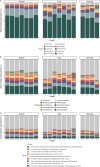Characteristics of gut microbiota profiles in Asian elephants (Elephas maximus) with gastrointestinal disorders
- PMID: 39779898
- PMCID: PMC11711614
- DOI: 10.1038/s41598-025-85495-0
Characteristics of gut microbiota profiles in Asian elephants (Elephas maximus) with gastrointestinal disorders
Abstract
Colic and diarrhea are common gastrointestinal (GI) disorders in captive Asian elephants, which can severely impact health and lead to mortality. Gut dysbiosis, indicated by alterations in gut microbiome composition, can be observed in individuals with GI disorders. However, changes in gut microbial profiles of elephants with GI disorders have never been investigated. Thus, this study aimed to elucidate the profiles of gut microbiota in captive elephants with different GI symptoms. Fecal samples were collected from eighteen elephants in Chiang Mai, Thailand, including seven healthy individuals, seven with impaction colic, and four with diarrhea. The samples were subjected to DNA extraction and amplification targeting the V3-V4 region of 16S rRNA gene for next-generation sequencing analysis. Elephants with GI symptoms exhibited a decreased microbial stability, as characterized by a significant reduction in microbiota diversity within individual guts and notable differences in microbial community composition when compared with healthy elephants. These changes included a decrease in the relative abundance of specific bacterial taxa, in elephants with GI symptoms such as a reduction in genera Rubrobacter, Rokubacteria, UBA1819, Nitrospira, and MND1. Conversely, an increase in genera Lysinibacillus, Bacteroidetes_BD2-2, and the family Marinifilaceae was observed when, compared with the healthy group. Variations in taxa of gut microbiota among elephants with GI disorders indicated diverse microbial characteristics associated with different GI symptoms. This study suggests that exploring gut microbiota dynamics in elephant health and GI disorders can lead to a better understanding of food and water management for maintaining a healthy gut and ensuring the longevity of the elephants.
Keywords: Captive; Colic; Diarrhea; Elephants; Gastrointestinal disorder; Gut microbiome.
© 2025. The Author(s).
Conflict of interest statement
Declarations. Competing interests: The authors declare no competing interests.
Figures






Similar articles
-
Analysis on gut microbiota diversity of wild Asian elephants (Elephas maximus) from three regions of Yunnan Province.Sci Rep. 2025 Jul 1;15(1):20692. doi: 10.1038/s41598-025-06798-w. Sci Rep. 2025. PMID: 40594486 Free PMC article.
-
Characteristics of gut microbiota in captive Asian elephants (Elephas maximus) from infant to elderly.Sci Rep. 2023 Dec 27;13(1):23027. doi: 10.1038/s41598-023-50429-1. Sci Rep. 2023. PMID: 38155244 Free PMC article.
-
Dysbiosis of the fecal microbiota in feedlot cattle with hemorrhagic diarrhea.Microb Pathog. 2018 Feb;115:123-130. doi: 10.1016/j.micpath.2017.12.059. Epub 2017 Dec 21. Microb Pathog. 2018. PMID: 29275129
-
Mechanism of inulin in colic and gut microbiota of captive Asian elephant.Microbiome. 2023 Jul 6;11(1):148. doi: 10.1186/s40168-023-01581-3. Microbiome. 2023. PMID: 37408039 Free PMC article.
-
Current state of knowledge: the canine gastrointestinal microbiome.Anim Health Res Rev. 2012 Jun;13(1):78-88. doi: 10.1017/S1466252312000059. Epub 2012 May 30. Anim Health Res Rev. 2012. PMID: 22647637 Review.
Cited by
-
Analysis on gut microbiota diversity of wild Asian elephants (Elephas maximus) from three regions of Yunnan Province.Sci Rep. 2025 Jul 1;15(1):20692. doi: 10.1038/s41598-025-06798-w. Sci Rep. 2025. PMID: 40594486 Free PMC article.
-
Comparative Analysis of Gut Microbiome Community Structures in Different Populations of Asian Elephants in China and Their Correlation with Diet.Genes (Basel). 2025 Apr 25;16(5):483. doi: 10.3390/genes16050483. Genes (Basel). 2025. PMID: 40428305 Free PMC article.
References
-
- Das, B. & Nair, G. B. Homeostasis and dysbiosis of the gut microbiome in health and disease. J. Biosci.44, 117 (2019). - PubMed
-
- Belizário, J. E. & Faintuch, J. Metabolic Interaction in Infection (Springer, 2018).
-
- Angkawanish, T. et al. Elephant health status in Thailand: the role of mobile elephant clinic and elephant hospital. Gajah31, 15–20 (2009).
Publication types
MeSH terms
Substances
Grants and funding
LinkOut - more resources
Full Text Sources
Medical

